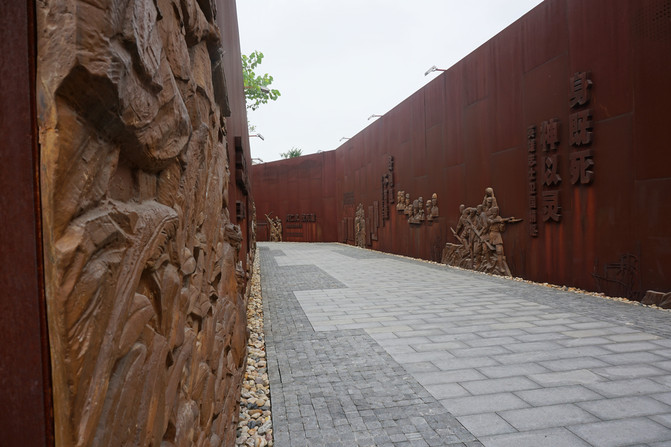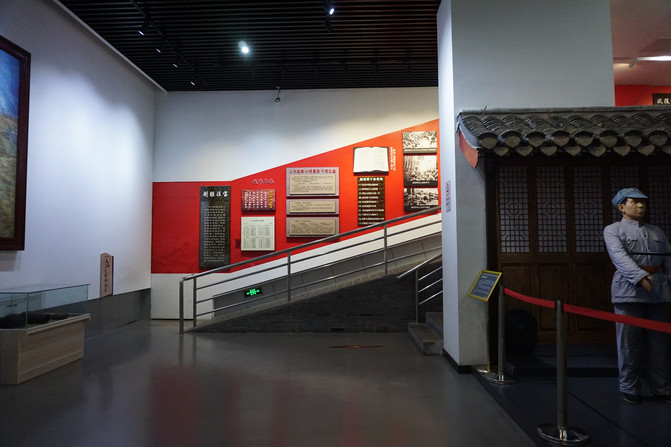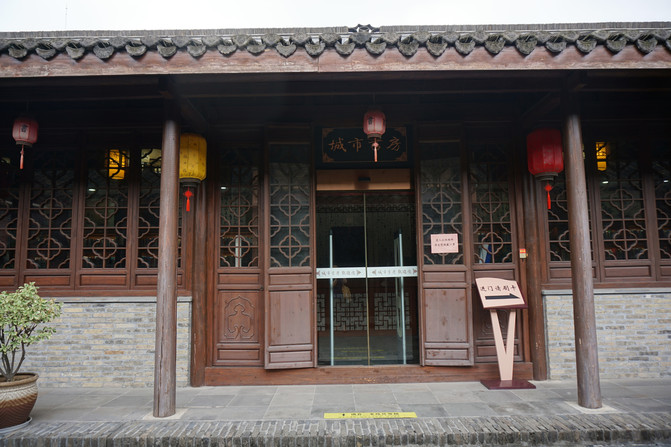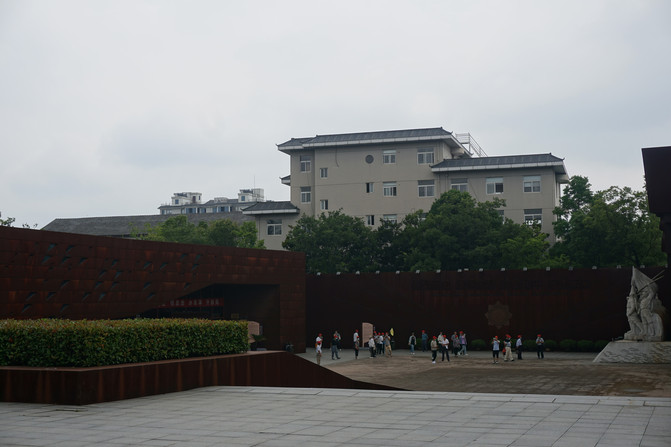Experience history in Gaoyou Cultural Park for the Last Battle of the Anti-Japanese War
Walking method: self-driving
Walking time: 2021.6
Walking route: Nanjing-Gaoyou Cultural Park for the Last Battle of the Anti-Japanese War-Gaoyou Lake Reedang Wetland Ecological Park-Nanjing
Walking attractions: Gaoyou Cultural Park for the Last Battle of the Anti-Japanese War
Address: No. 70 Xihe Lane, Gaoyou City
The team activities came to Gaoyou Cultural Park, the last battle of the Anti-Japanese War.

Entering from the south gate of the Cultural Park, you can see the big sign of "Victory Square, the last battle of the Anti-Japanese War" not far away, like a sharp sword unsheathed and piercing into the sky.

Register at the Tourist Activity Center and ask the tour guide to lead us around and explain, so that we can better understand this period of history and that extraordinary years.

Tall ginkgo trees and low shrubs make this place look lush

Follow the guide and start the tour.

The symbol "Victory Square, the last battle of the Anti-Japanese War," is 19.45 meters high, meaning that the Chinese nation achieved a comprehensive victory in the Anti-Japanese War in 1945.

Follow the signs into the tunnel

At the entrance of the Anti-Japanese War Corridor, the rust-red background makes people immersed in the vicissitudes and gloomy historical conception.

Both sides of the corridor are made of rust red weather-resistant steel materials to make majestic embossed walls.

The embossed wall is divided into 14 sculpture units, showing the 14-year arduous journey of the Chinese military and civilians in fighting against the invaders.

On the wall of the "Warrior, Defend the Four Directions" section, there are lyrics and songs that read "The big sword is cut off on the heads of the devils", and there are also statues of an image soldier holding a big sword in his hand.

The "body is dead, God is the spirit" section. Walking during this journey, there are winding corridors, high walls, and rusty red walls on both sides of the road that create awe and shock from the bottom of our hearts. The walls on both sides of the road are engraved with the historical process of the Anti-Japanese War.

Mountains and rivers are broken, the nation is awakened, and we are united against the enemy

The heroic morale of "Sanduo River, Playing Victory Song"

The heroic spirit of "being strong in the end and untouchable".

The names and brief introduction of the ten major battles of the Anti-Japanese War, as well as a heroic and proud sculpture of a victorious soldier in the Anti-Japanese War

We moved forward slowly with the guide's footsteps. While listening to the explanation, we appreciated the lifelike embossed on the wall. Wall embossed such as the September 18th Incident, the Lugouqiao Incident, and the Nanjing Massacre have stepped through the 14 years of the War of Resistance against Japanese Aggression. It was like hearing the sound of a clarion horn blowing, seeing the great pain and spiritual cracks caused by Japanese imperialism to the Chinese people, and seeing scenes of the people reiterating against the enemy, charging into the front, and rushing out to break out of the encirclement and finally achieving victory.

At the end, Victory Square suddenly became clear, and the square enclosed on three sides was spacious and atmospheric.


The theme sculpture "Victory Moment" in Victory Square stands in a corner. The sculpture is 12.26 meters high, implying the liberation of Gaoyou City on December 26, 1945. The upper part of the sculpture is an abstract silhouette of the national flag, the bottom is an embossed of reed swamps, and the middle is a vivid scene of five New Fourth Army soldiers celebrating the victory of the Anti-Japanese War.

Stop at Victory Square and see an auditorium standing directly in front of it. It is solemn and solemn. This is the "Memorial Hall of the Last Battle of the Anti-Japanese War".

The south of the square is engraved with 16 characters: "Remember history, remember martyrs, cherish peace and create the future."

The sacred and solemn white auditorium is a Republican building that combines Chinese and Western cultures. It was originally a church opened by the British.

Regional guide map and introduction of the memorial hall

The bronzed "Memorial Hall of the Last Battle of the Anti-Japanese War" is on a black sign on the east side of the auditorium

Entering the solemn gate and entering the memorial hall, I followed the tour guide to understand the beginning and end of the Battle of Gaoyou according to the Timeline. On one telegraph wall there is a telegram from General Su Yu restoring the cause of the Gaoyou Campaign. There is also a copy of the electronic manuscript of the Central Military Commission agreeing to launch the Gaoyou Campaign, which is of special historical significance for restoring the Gaoyou Campaign. A combat map clearly reproduces the combat deployment of that year...

In the center of the first floor of the memorial hall, city walls, moats, miniature landscapes, etc. are set. Coupled with the combination of acoustic and optical technology, the style of Gaoyou City at that time is reproduced and the terrain of the war confrontation at that time is also displayed.

There is a sunken glass inside the wall that displays Gaoyou's urban style, terrain and battle situation through a sand table.

The entire process of the Gaoyou Campaign was displayed in the form of photos, objects, micro-movies, etc.


Here, in the form of sculptures and oil paintings, the Japanese surrender ceremony held in this auditorium in the early morning of December 26, 1945 is restored, bringing us into a sacred and solemn atmosphere. In the center of the room, there is a long square table with the Japanese commander on one side, handing over the Japanese roster to the commander of the New Fourth Army, expressing unconditional surrender. The wall shows Su Yu wearing the military uniform of the New Fourth Army, crowded among the crowd, watching the surrender ceremony in front of him with a victorious smile. This surrender ceremony was the largest surrender ceremony held by the Communist Party of China and the New Fourth Army under its leadership. It was also the last surrender ceremony for the Japanese invaders to surrender to the Eighth Route Army and the New Fourth Army under the leadership of the Communist Party of China.

The memorial hall is divided into 6 parts, the first part: the pre-war situation; the second part: the strategy; the third part: the battle process; the fourth part: the surrender ceremony; the fifth part: the magic weapon to win; and the sixth part: the significance of the battle. Climb up the stairs to continue the visit on the second floor.

Exhibition layout overlooking the first floor

A historical picture of the entire wall is used here. The literature explains why the Battle of Gaoyou was recognized as the last battle of the Anti-Japanese War.

Walking out of the memorial hall, there are several rows of green brick and small tiled houses on one side of the hall that are Wang Zengqi's study room. This is now a city study.


The bluestone, vermilion doors and windows, and hanging red lanterns, especially the quiet and quiet atmosphere without tourists, has the atmosphere of a study.

The efficacy of the city study

There are also some exhibitions of Gaoyou's historical materials

Walking around the quiet study room, we arrived at Victory Square.

Shengli Sculpture

Historical Corridor. This is Gaoyou's cultural park for the last battle of the Chinese military-civilian War of Resistance. Victory Square, the Anti-Japanese War Corridor, and the memorial hall comprehensively and three-dimensionally reproduces the history of China's Anti-Japanese War. It always reminds us to learn from history, not to forget the national humiliation, work hard, and guide us to forge ahead and forge ahead bravely towards the goal of the great rejuvenation of the Chinese nation!

